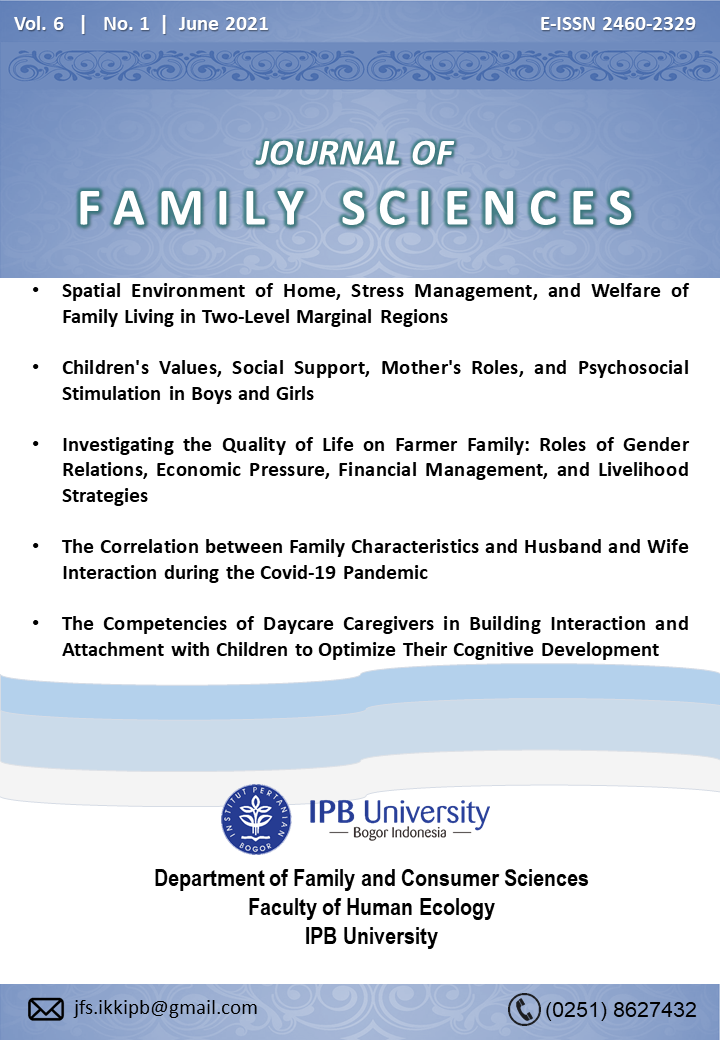The Competencies of Daycare Caregivers in Building Interaction and Attachment with Children to Optimize Their Cognitive Development
Abstract
Families whose parents are both working have limited time in nurturing their children. This circumstance makes parents, especially mothers, alternate parenting to the babysitter or caring institution called daycare. This study aimed to analyze the correlation of children's characteristics, caregiver-child interaction, and attachment with the cognitive development of preschool children in daycare. This study used a cross-sectional study design with the daycare (TPA) selection as the research location carried out purposively located in the buffer areas of the capital city of DKI Jakarta. Respondents in this study were 39 children aged 2.5-6.4 years with complete parents and 16 caregivers from four selected TPA who interacted with their children daily. Data was collected by means of in-depth observations to measure the interaction variables between caregivers and children. This study indicates a positive correlation between caregiver-child interaction and attachment with a child's cognitive development. This study also found a significant positive relationship between the caregivers-child interaction with caregivers-child attachments and a significant negative relationship between the child's age and the caregivers-child attachment. This shows that interaction, and attachment between caregivers and children are important factors that can improve cognitive development while in TPA.
Downloads
References
Bernal, R. (2008). The effect of maternal employment and child care on children's cognitive development. International Economic Review, 49(4),1173-1209.
Berns, R. (2012). Child, family, school, community: Socialization and support. Nelson Education. Eight edition.
Blegur, L., Fatimah, & Aminah. (2014). Pola asuh dan perkembangan anak ditempat penitipan anak. Pediatric Nursing, 1(1), 5-8.
Badan Pusat Statistik. (2014). Survei Komuter Jabodetabek 2014. Jakarta (ID) : Badan Pusat Statistik.
Badan Pusat Statistik. (2016). Indikator Pasar Tenaga Kerja Indonesia 2016. Jakarta (ID): Badan Pusat Statistik.
Badan Pusat Statistik. (2017). Keadaan angkatan kerja di Idonesia Februari 2017. Katalg BPS No. 04120.1702.ISSN.0126-647X.
[BPS DKI Jakarta] Badan Pusat Statistik Provinsi DKI Jakarta. (2017). Keadaan ketenagakerjaan di DKI Jakarta Februari 2017. Berita Resmi Statistik No. 27/05/31/Th.XIX.
Bronfenbrenner, U. (1979). The Ecology of Human Development: Experiments by Nature and Design. UK: Harvard University Press.
Burchinal, M. R., Roberts, J. E, Nabors, L. A., & Bryant, D. M. (1996). Quality of center child care and infant cognitive and language development. Child Development, 67,606–620.
Burchinal, M. R., Roberts, J. E., Riggins, J. R., Zeisel, S. A., Neebe, E., & Bryant, D. (2000). Relating quality of center‐based child care to early cognitive and language development longitudinally. Child development, 71(2), 339-357.
Carl, B. (2007). Child caregiver interaction scale. [Dissertation]. Indiana University of Pennsylvania.
Chlid and Youth Studies Group The Open University. (2007). Attachment Relationships : Quality of care for Young Chindren. Dalam Woodhead M dan Oates J (Ed). United Kingdom (UK) : The Open University
Commodari, E. (2013). Preschool teacher attachment, school readiness and risk of learning difficulties. Early childhood research quarterly, 28, 123-133.
Duncan, G.J., & National Institute of Child Health and Human Development Early Child Care Research Network. (2003). Modeling the impacts of child care quality on children's preschool cognitive development. Child Development, 74(5), 1454-1475.
Halle, T., Anderson, R., Blasberg, A., Chrisler, A., & Simkin, S. (2011). Quality of Caregiver–Child Interactions for Infants and Toddlers (QCCIIT): A Review of the Literature. Washington, DC: US Department of Health and Human Services, OPRE.
Handayani, S. P. (2014). Pola pengasuhan anak pada taman penitipan anak ‘Aisyiyah Wilayah Riau. Jurnal Online Mahasiswa (JOM), 1(2), 1-15.
Hastuti, D. 2015. Pengasuhan: teori dan prinsip aplikasinya di Indonesia. Bogor. Institut Pertanian Bogor.
Hikmah, S. (2014). Optimalisasi perkembangan anak dalam day care. Jurnal Sawwa Studi Gender, 9(2), 345-360.
Latifah, E. W., Krisnatuti, D., & Puspitawati, H. (2016). Pengaruh pengasuhan ibu dan nenek terhadap perkembangan kemandirian dan kognitif anak usia prasekolah. Jurnal Ilmu Keluarga dan Konsumen, 9(1), 21-32.
Maharta, R. P. (2017). Hubungan Interaksi Pengasuh dengan Personal Sosial Anak Usia 3-5 Tahun di TPA Pelangi Anak Negeri dan TPA Happy Bear Group Yogyakarta. Skripsi. Yogyakarta(ID): STIKES Jenderal Achmad Yani Cimahi
Monika, S. (2014). Motivasi orang tua menitipkan anaknya di daycare. Provitae Jurnal Psikologi Pendidikan, 6(1), 38-57.
National Institute of Child Health and Human Development Early Child Care Research Network. (2000). The relation of child care to cognitive and language development. Child Development, 71(4), 960-980.
Santrock, J. W. (2007). Psikologi Pendidikan. Ed 2. Jakarta : Prenada media Group.
Santrock, J. W. (2011). Perkembangan Anak. Ed 11(1). Jakarta : Erlangga.
Saputra, F., Hasanah, O., & Sabrian, F. (2015). Perbedaan tumbuh kembang anak toddler yang diasuh orang tua dengan yang dititipkan ditempat penitipan anak (TPA). JOM. 2(2), 1123-1130.
Schipper, E. J., Marianne, R. M. J., & Geurts, S. A. (2006). Effects of child–caregiver ratio on the interactions between caregivers and children in child‐care centers: an experimental study. Child Development. 77(4), 861-874.
Susanto, A. (2011). Perkembangan Anak Usia Dini: Pengantar dari berbagai Aspeknya. Jakarta (ID): Kencana.
Yuliastanti, T. (2013). Keberhasilan bounding attachment. Jurnal Kebidanan, 5(02):8.
Uce, L. 2017. The golden age: masa efektif merancang kualitas anak. Bunayya: Jurnal Pendidikan Anak, 1(2), 77-92.
Copyright (c) 2021 Journal of Family Sciences

This work is licensed under a Creative Commons Attribution 4.0 International License.
Authors who publish with this journal agree to the following terms:
- Authors retain copyright and grant the journal right of first publication with the work simultaneously licensed under

This work is licensed under a Creative Commons Attribution 4.0 International License. that allows others to share the work with an acknowledgement of the work's authorship and initial publication in this journal. - Authors are able to enter into separate, additional contractual arrangements for the non-exclusive distribution of the journal's published version of the work (e.g., post it to an institutional repository or publish it in a book), with an acknowledgement of its initial publication in this journal.
- Authors are permitted and encouraged to post their work online (e.g., in institutional repositories or on their website) prior to and during the submission process, as it can lead to productive exchanges, as well as earlier and greater citation of published work (See The Effect of Open Access).



_001.png)



